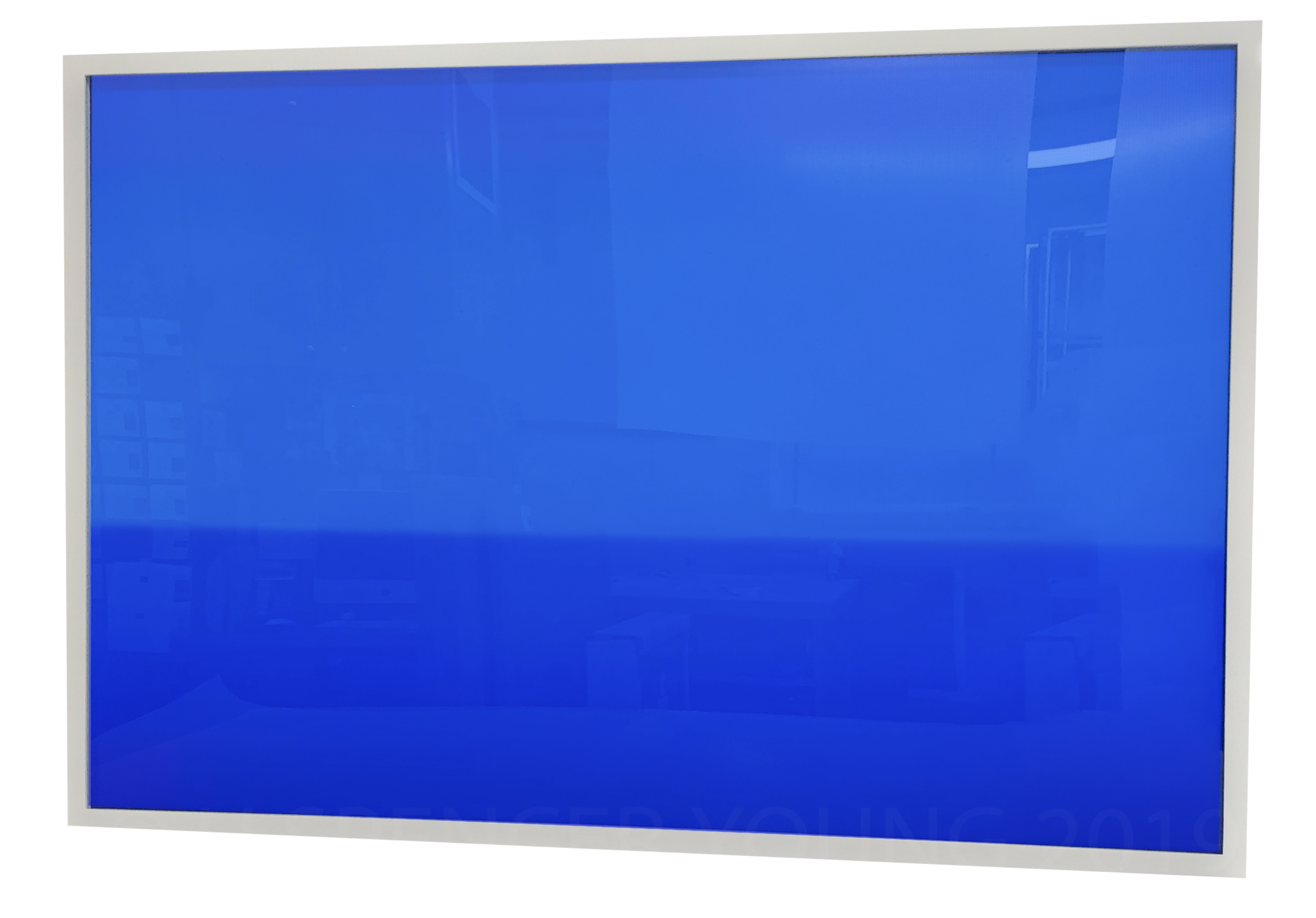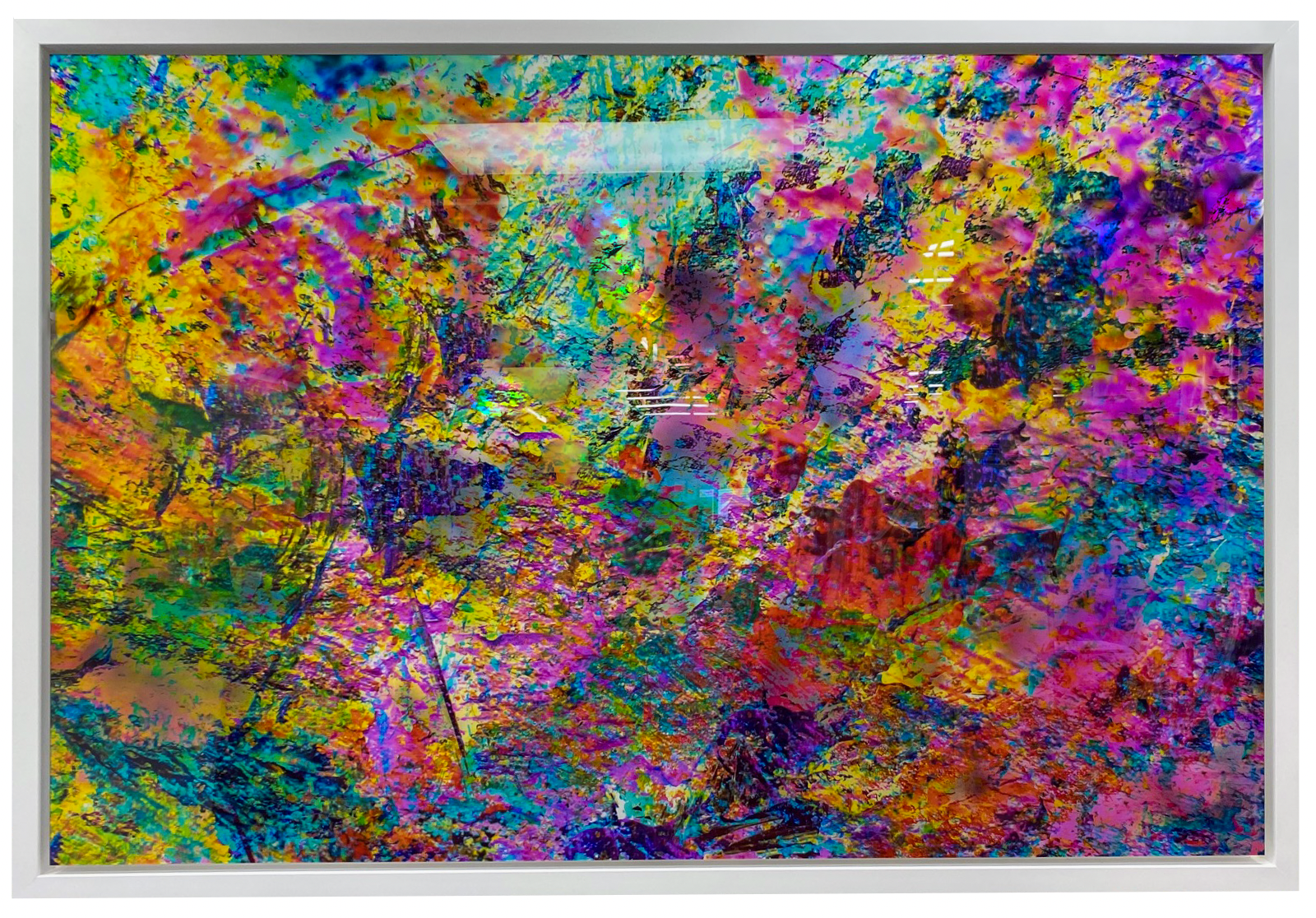


Montage, 2021
Triptych, ultraviolet ink on cast Plexiglas with custom stainless-steel hardware
Each panel: 28 × 18.6 × 1.5 in (71.1 × 42.2 × 3.8 cm)
Total weight 105 lb (35 lb per panel)
Installation view above left and center: Art Basel | Miami, Untitled Art, Miami, FL 2022
Montage, 2021, explores the accelerating dematerialization and entropy of images and image-making. In an expanded approach to mark-making, the forms are generated through physical movements of red, green, and blue light sources—around an exposed digital camera sensor—from varied spatial positions and distances.
The resulting magenta and blue fragments are not digitally composed but arise through optical interaction. Each form is a self-reflexive shadow contour: the internal and external structure of the camera body casting itself back onto the sensor. Red, green, and blue were chosen for their role as the additive primaries of light.
The object dimensions correspond to standard digital photographs, rotated vertically to emphasize their physicality. This reorientation encourages the viewer to perceive them as objects rather than images. Their thickness was selected to heighten each site’s perceptual interaction, and the gap between object and wall directly affects the saturation via affecting the opacity of the object.
The work is tangentially inspired by the Double Slit Experiment—the foundational quantum physics trial that revealed light’s dual nature as both particle and wave. That paradox of image and event is echoed here: the pieces function simultaneously as traces and phenomena.
Finally, the work reflects a multi-generational legacyin real estate and construction. Reoriented horizontally and stacked, the forms resemble bricks; vertically aligned, they become windows. Mounted edge to edge, they form a wall. Their meaning shifts with physical arrangement, just as their formation emerged from the spatial choreography of light and body.


Foundations, 2014
Recursive architecture.
LightJet Ilfochrome on Dibond, artist’s frame
36 × 67.5 × 4 in (91.4 × 171.5 × 10.2 cm)
Edition of 3 + 2 AP
Edition fully placed
Foundations, 2014 is a doubled photocollage composed of gesturally made photographs, arranged like bricks to suggest stability and structure. By placing the camera sensor in the role of the canvas, the work explores gesture, aura, texture, facture, and the artist’s hand within photography—capturing moments where a camera and a painting are both in motion and in dialogue during the process. Each image is rich in color, light, movement, and texture, representing a confluence of mediums with a long, sometimes contentious, shared history. Printed as a Lightjet Ilfochrome—now a permanently discontinued process—this work is irreproducible in its original format.


Severe Clear, 2014/2019
Chromatic atmospheres
Chromogenic print on Dibond, maple frame, museum glass (artist’s frame)
43 × 63 × 2 in (109.2 × 160 × 5.1 cm)

Geomorphology, 2014/2020
Chromogenic print (FujiFlex) mounted to Dibond (composed in-camera from multiple painted surfaces; no digital post-production)
50 × 70 in (127 × 177.8 cm)
Geomorphology, 2014/2020, presents a bird’s-eye view of a digitally mediated world, where the real and the virtual become increasingly difficult to separate. This new landscape is realized as a fantastical, topographical photocollage that ultimately resides as a photograph. Gestures are first made with oil and acrylic paint on wood panels. Through iterative photographic processes and chance, the composition emerges. The camera sensor and chip intervene as new agents of gesture, imprinting their inherent characteristics onto the image. Although photography traditionally offers a flat, smooth surface lacking the facture of painting, here, through experimentation and time, layers of paint and photography merge into a newly imagined terrain.


Turboparalysis, 2014
Lens-based automatism
Wall sculpture
Laminated handmade Ilfochrome print in welded aluminum frame (collaged from multiple 120 film exposures, transferred to 8×10 film)
51 × 51 × 2 in (129.5 × 129.5 × 5.1 cm
Part of an ongoing inquiry into lens-based media operating in non-depictive, automatistic states, Turboparalysis traces the azure sky over Lower Manhattan onto a single roll of 120 film—shot, rewound, and re-exposed to inscribe gestural intervals onto each frame. The images are then scanned and subjected to recursive transformations: doubling, inverting, rotating, until a latticework diamond emerges, balanced delicately on its axis. Transferred to 8×10 film and hand-printed as unique Ilfochromes, these works hover between analog and digital registers. No two are identical, each sustaining a precarious architecture of chance and control.